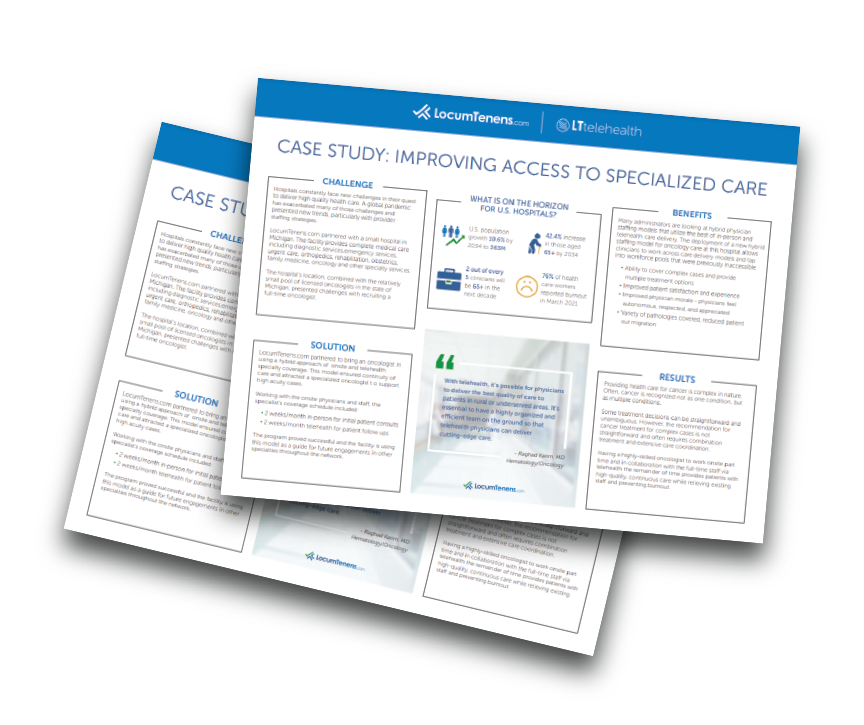How one facility used a flexible approach to provide much-needed specialty care to their community.
Care access is changing in the U.S., and hospitals are grappling with the domino effects of the global pandemic. One trend in medical staffing that takes a cue from the rise of telehealth is a hybrid staffing model that fills the gaps by strategically employing onsite and telehealth roles where each is needed. But does a hybrid telehealth staffing model work? During a recent case study in partnership with a regional hospital facility, LocumTenens.com took a close look at the hurdles associated with access to care in today's labor environment. Here are the findings.

Challenge: Filling the gaps in medical care
Hospitals constantly face new challenges in their quest to deliver high-quality health care. A global pandemic has exacerbated many of those challenges and presented new trends, particularly with provider staffing strategies.
LocumTenens.com partnered with a small hospital in Michigan. The facility provides complete medical care including diagnostic services, emergency services, urgent care, orthopedics, rehabilitation, obstetrics, family medicine, oncology and other specialty services.
The hospital’s location, combined with the relatively small pool of licensed oncologists in the state of Michigan, presented challenges with recruiting a full-time oncologist.
Benefits of a hybrid staffing model
Many administrators are looking at hybrid physician staffing models that utilize the best of in-person and telehealth care delivery. The deployment of a new hybrid staffing model for oncology care at this hospital allows clinicians to work across care delivery models and tap into workforce pools that were previously inaccessible.
- Ability to cover complex cases and provide multiple treatment options
- Improved patient satisfaction and experience
- Improved physician morale - physicians feel autonomous, respected, and appreciated
- Variety of pathologies covered, reduced patient out migration
Solution
LocumTenens.com partnered to bring an oncologist in using a hybrid approach of onsite and telehealth specialty coverage. This model ensured continuity of care and attracted a specialized oncologist to support high acuity cases.
Working with the onsite physicians and staff, the specialist's coverage schedule included:
- 2 weeks/month in-person for initial patient consults
- 2 weeks/month telehealth for patient follow ups
The program proved successful and the facility is using this model as a guide for future engagements in other specialties throughout the network.

Results
Providing health care for cancer is complex in nature. Often, cancer is recognized not as one condition, but as multiple conditions.
Some treatment decisions can be straightforward and unambiguous. However, the recommendation for cancer treatment for complex cases is not straightforward and often requires combination treatment and extensive care coordination.
Having a highly-skilled oncologist to work onsite part time and in collaboration with the full-time staff via telehealth the remainder of time provides patients with high-quality, continuous care while relieving existing staff and preventing burnout.
Conclusion
With the combination of part-time in-person physicians with attentive full-time telehealth staff, hospitals can be more flexible than ever before while preventing interruptions in care for their communities.
Dr. Raghad Karim, MD (Hematology/Oncology) shared this assessment: "With telehealth, it's possible for physicians to deliver the best quality of care to patients in rural or underserved areas. It's essential to have a highly organized and efficient team on the ground so that telehealth physicians can deliver cutting-edge care."
Looking ahead
Now more than ever, hospitals around the country must be looking ahead towards the evolving needs of their communities. As the population grows and ages, and health care workers leave the profession to retire or change industries, a hybrid model that makes strategic use of telehealth alongside in-person care will become critical.
Get in touch with our knowledgeable team today to find a staffing solution that fits your facility's needs.

